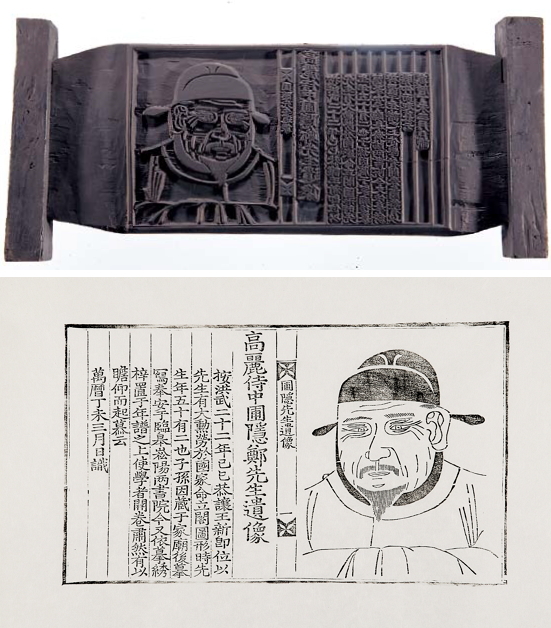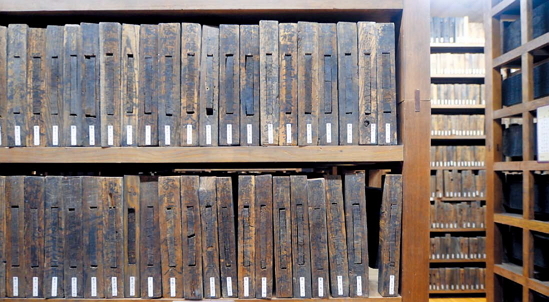ANDONG, North Gyeongsang Province ― The legacy of Joseon, Korea’s last ruling dynasty, is alive and strong in this historic town.
Billed as the heartland of Korean Confucianism, Andong boasts a number of private Confucian academies and clan villages from the 1392-1910 Joseon era, living proof that this region was home to many of the most prominent Confucian scholars of the time.
What’s little known to the outside world, and even to many Koreans, is that the essence of the spiritual world of Joseon’s Confucianism-based society was meticulously captured on thousands of wooden slabs.
Housed at the Advanced Center for the Korean Studies here in Andong, Joseon’s printing woodblocks are a timeless treasure that “holds a key to understanding the very consciousness of the ancestors who sought to realize a Confucianism-based ideal society,” says Park Soon, a senior researcher at the institute.
Confucian printing woodblocks
Confucian printing woodblocks are a collective name given to the ACKS collection which consists of 64,226 hand-carved wooden panels produced between 1460 and 1956 for the printing of 718 books.
The collection may soon be recognized as a world treasure, as the Korean government in February recommended it for inclusion in UNESCO’s Memory of the World Register. A decision on the application is expected in June 2015.
Not long ago, however, these precious timbers were in the pocession of individuals, families or private academies that were finding it increasingly burdensome to keep them.
“I knew (the woodblocks) were something very important even when I was a child. I knew they were passed down to us from generation to generation, although I didn’t exactly know what they were and their value,” said Lee Pang-soo. Lee is a ninth-generation descendent of Lee Sang-jeong, a prominent 18th-century Joseon scholar.
The Lee clan, which he now heads, was one of the first to donate artifacts to the ACKS by entrusting its entire collection of 2,890 antiques in 2002, including old books, documents and woodblocks.
 |
Poeun Collection of Works, a compilation of works by 14th-century scholar and official Jeong Mong-ju engraved in 1866, is among the Advanced Center for Korean Studies’ woodblock collection. (ACKS) |
Park of the center explained that it was because of the difficulty of preserving the woodblocks at a private level ― at clans’ head houses or Confucian academies ― that the state-funded ACKS launched a campaign in 2002 to collect the relics. The result is the more than 64,000 panels now housed at the center’s state-of-the art storage facility.
“There was a substantial risk of theft and damage too,” he added.
Although the Confucian printing woodblocks are often likened to the Tripitaka Koreana, an 800-year-old Buddhist scripture engraved on over 80,000 woodblocks, the ACKS collection differs greatly because it is a collection that was put together only recently through the necessity of preservation.
While the Buddhist woodblocks contain the teachings of Buddha and were produced by the Goryeo Dynasty, which preceded Joseon, to promote Buddhism, the Confucian printing blocks were not the product of a big state project.
They were carved by private groups to pass on the learning of sages, and have been preserved and handed down by successive generations of scholars, said Choi Soon-guen, a senior curator at the National Folk Museum of Korea who led an exhibition of those blocks in June.
The writing carved on the blocks varies from genealogies to textbooks for children, with the vast majority, 583 titles out of a total 718, being literary writings of scholars. They cover diverse genres such as letters, daily journals, poems and academic papers.
“The woodblocks give a detailed picture of Joseon’s literati, how they lived, what they studied and mostly talked about,” he said.
Exceptional value
Although the woodblocks were made to print books, they meant much more than just a printing medium to Joseon scholars and their descendants in centuries that followed.
In order to praise, preserve and build on the enlightenment of their ancestors, Joseon’s scholars and intellectuals led the publishing of books using woodblocks in a process researchers now describe as “community publishing.”
“It was a voluntary publication, conducted by clans and schools,” explained professor Suh Kyung-ho of Seoul National University in Seoul.
In China, where the woodblock printing technology originated, woodblock production was led mostly by commercial publishers for a mass production of books.
But in the Joseon society, local groups of intellectuals, with a network of family clans, kindred scholars, private academies and local supporters, decided what to publish and oversaw the entire production. They also divided up the required costs among themselves.
The phenomenon reached its peak in the 18th and 19th centuries, when family clans began publishing the works of their ancestors in a competitive manner.
 |
Over 64,000 woodblocks are housed at Jangpangak, a special storage facility of the Advanced Center for Korean Studies, in Andong, North Gyeongsang Province. (Ahn Hoon/The Korea Herald) |
“It was a result of a unique interpretation of publication among the literati of Joseon,” Suh explained. Woodblock printing was seen as an act of practicing the ruling ideology of the era and passing the sages’ enlightenment down to the descendants, he explained.
Park of the ACKS adds that through such practices, the intellectuals of Joseon could communicate through texts by learning from scholars of earlier times and reflecting on their academic achievements carved onto wood and then again by their own enlightenment being handed down to future generations in the same way. All for the common ideology of Confucianism.
“It is an example of collective intelligence unprecedented in world history, with the exception of religious communities,” Park said.
By Lee Sun-young (
milaya@heraldcorp.com)









